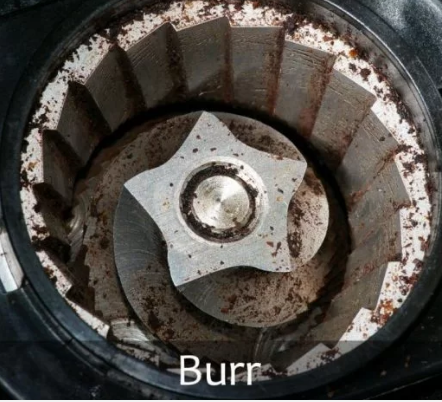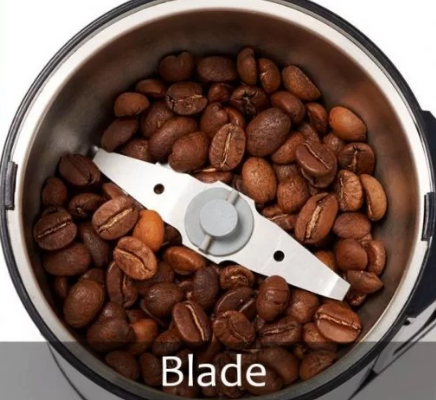Table of Contents
Introduction
Coffee lovers realize that the key to an incredible mug of coffee starts with the grind. The two most powerful burr grinders, vs. blade grinders, assume a pivotal role in deciding the flavor and nature of your blend. In this article, we’ll explore the differences between these two grinders, their upsides and downsides, and which one may be the best fit for you.
Understand Burr grinder

A burr grinder is a coffee grinding gadget that utilizes two rotating burrs (level or conelike) to smash coffee beans into a uniform size. These burrs can be adjusted in accordance with controlling the grind size, making the grinder a 1 among coffee fans.
Sorts of Burr grinders
Level Burr Grinders: Utilize two level plates to smash the beans. Known for their accuracy and consistency.
Cone-shaped Burr Grinders: Element cone-molded burrs, offering productive crushing with less intensity age.
Burr Processors
Steady grind Size:
Burr grinders give uniform molecule sizes, guaranteeing even extraction during blending. This prompts a fair and delightful mug of coffee.
Customizable Toil Settings:
With burr grinders, you can adjust the drudgery size to suit different blending techniques (e.g., coffee, French press, pour-over).
Hold coffee Flavor:
By creating less intensity during crushing, burr grinders assist with safeguarding the regular oils and kinds of the coffee beans.
Strength:
Most burr grinders are made with excellent materials, making them durable and dependable.
Burr grinders
Cost:
Burr grinders are by and large more costly than sharp-blade grinders, with costs going from $50 to more than $500.
Size and Weight:
These grinders are bulkier and heavier, requiring all the more counterspace.
Support:
Cleaning burr grinders can time-consume, as need might arise to be routinely cleaned to forestall development.
Understand cutting-blade grinder

Cutting-Blade grinders utilize a turning sharp blade to cleave espresso beans into more modest pieces. These grinders are many times more reasonable and smaller, making them famous for easygoing espresso consumers.
How blade grinders Work
Blade grinders have a solitary blade that turns at high velocity, cutting the espresso beans. The subsequent toil size relies on how long the coffee is worked.
Cutting-edge Processors
Reasonableness:
Cutting-blade grinders are a lot less expensive, with costs ordinarily going from $15 to $50.
Simple of Purpose:
Straightforward plans and activities make cutting-blade grinders easy to understand.
Smaller and Lightweight:
These processors are small and compact, ideal for restricted counter space or travel.
Flexibility:
Cutting-edge processors can likewise be utilized for crushing flavors and spices, making them multifunctional.
Edge Processors
Conflicting Toil Size:
Cutting-blade grinders frequently produce lopsided drudgery sizes, prompting an unequal extraction and severe espresso.
Heat Age:
The quick-turning cutting edge produces heat, which can adjust the grinder’s flavor by consuming the beans’ oils.
Absence of accuracy:
Blade grinders offer zero command over grind size, making them unsatisfactory for specialty blending strategies.
Sturdiness Issues:
Cutting-blade grinders are by and large produced using lower-quality materials and may not keep going as far as burr grinders.
Key Differences Between Burr and Blade Grinders
| Feature | Burr Grinder | Blade Grinder |
|---|---|---|
| Grind Consistency | Highly consistent | Inconsistent |
| Adjustability | Precise control over grind size | No control |
| Flavor Preservation | Preserves natural oils | May burn oils |
| Cost | Expensive | Affordable |
| Ease of Use | Requires some learning | Simple operation |
| Size | Bulkier | Compact |
| Durability | Long-lasting | Shorter lifespan |
Which one would it be advisable for you to pick?
The decision between a burr grinder and a blade grinder to a great extent relies upon your espresso inclinations, financial plan, and preparing style.
Pick a Burr Processor If:
You’re a coffee lover who values quality and flavor.
You mix espresso utilizing strategies that require exact drudgery sizes, like coffee or pour-over.
You’re willing to put resources into an enduring grinder.
Pick a sharp-blade grinder If:
You’re an easygoing espresso consumer or new to coffee grinding.
You’re on a tight spending plan and need a reasonable choice.
You’re searching for a reduced, multi-reason grinder.
Conclusion
In the discussion between burr grinders vs. blade grinders, there’s no one-size-fits-all response. Burr grinders succeed in consistency, flavor conservation, and adaptability, making them the best decision for serious coffee lovers. Cutting-blade grinders, then again, are a savvy and helpful choice for the individuals who focus on straightforwardness.
Eventually, the best grinders for you depend upon your fermenting inclinations and the amount you’re willing to put resources into your coffee process. Whichevergrinders you pick, remember that newly ground coffee will constantly taste better compared to pre-ground, carrying you one bit nearer to the ideal

1 thought on “Burr Grinders vs. Blade Grinders: Which Is Better for Your Coffee?”